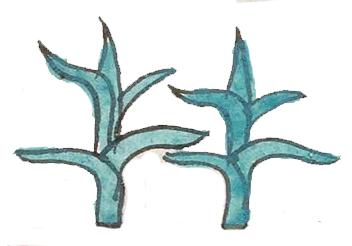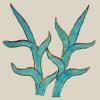acatl (Mdz36r)
This element was carved from the compound glyph for the place name Acamilixtlahuacan. It consists of two, tall, leafy, turquoise-colored reed plants (acatl).
Stephanie Wood
This element for reed/cane shows classic plants, painted a classic color. Reeds were year signs in the Mesoamerican calendar and day signs in the day count (tonalpohualli). Reeds also had many practical uses, one of which was for making darts and arrows. Thus, some of the attestations of the glyph for acatl will look a lot like darts and arrows acatl) or mitl, with their red and yellow coloration at each end and with added feathers, but without the arrowhead. The added arrowhead is more likely meant to convey mitl, not just acatl. The use of two acatl plants may be intended here as a plural for acatl, or it may be artistic license, given that such plants often grow in multiples.
Wikipedia has published a photo of acatl plants.
Stephanie Wood
Stephanie Wood
c. 1541, but by 1553 at the latest
Stephanie Wood
reeds, canes, plants, xiuhpohualli, año, turquesa, xihuitl

aca(tl), reed, https://nahuatl.wired-humanities.org/content/acatl
reed
la caña
Stephanie Wood
Codex Mendoza, folio 36 recto, https://digital.bodleian.ox.ac.uk/objects/2fea788e-2aa2-4f08-b6d9-648c00..., image 82 of 188.
The Bodleian Libraries, University of Oxford, hold the original manuscript, the MS. Arch. Selden. A. 1. This image is published here under the UK Creative Commons, “Attribution-NonCommercial-ShareAlike 3.0 License” (CC-BY-NC-SA 3.0).



